Road Test: 2013 Porsche 911 Carrera S Cabriolet
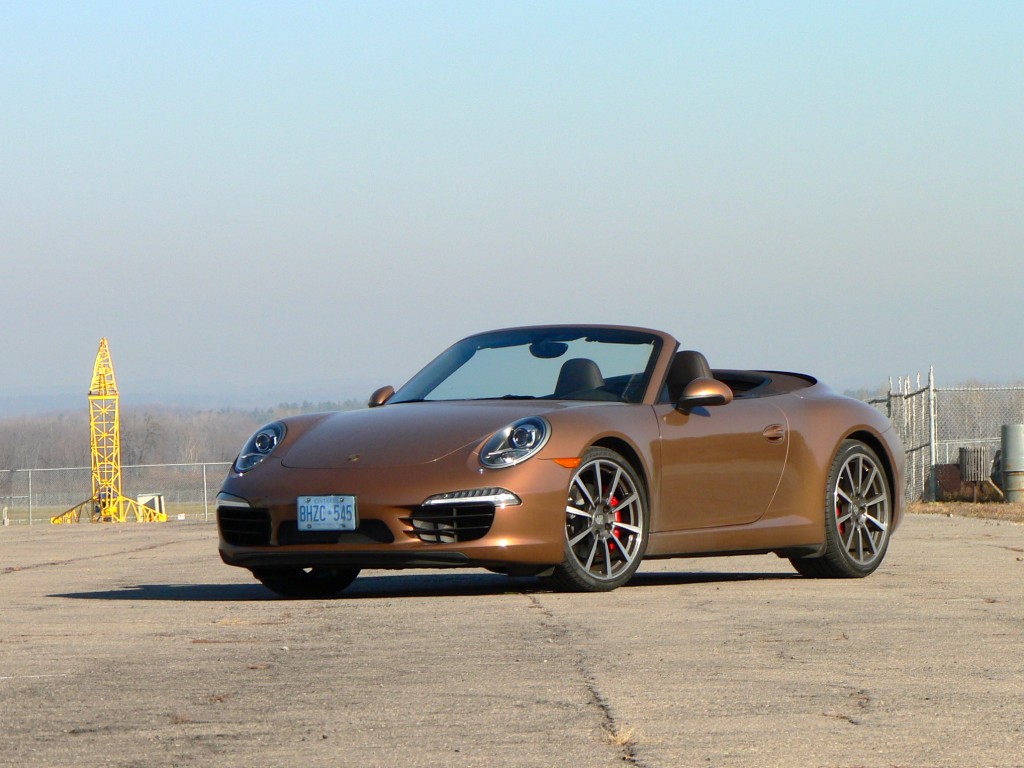 Story and photos by John LeBlanc
For a relatively small automaker like Porsche, having upwards of twenty-odd variations of one model to launch can take some time. In the case of the brand’s cornerstone 911, it can take years.
For instance, the all-new 911 — internally codenamed 991 — debuted at the 2011 Frankfurt auto show in base Carrera and Carrera S coupe forms. It’s been over a year and we’re still waiting for the iconic Turbo. But open-air motoring fans will be happy to know that the convertible iterations, such as my 2013 911 Carrera S Cabriolet, are now on-sale.
While Porsche’s two-seat Boxster and Cayman remain the brand’s entry-level offerings, the 911 2+2 retains its top-dog status. As such, 911 pricing can get, well, pricey, and awfully quickly. Virtually no one buys a “base” Porsche 911 Carrera anymore. So for reference purposes only, a 350 horsepower 911 Carrera hardtop coupe with a seven-speed manual gearbox starts at $93,700. Dropping the top adds $13,200 for the Cabriolet edition. Adding the 50-hp more powerful S engine brings the starting price of my 911 Carrera S Cabriolet to $123,200. I say, “starting”, because my tester also had an Audi A4’s worth of options (metallic paint; heated and ventilated front seats; automatic transmission; 20-inch wheels; Porsche Dynamic Light system; Sport Chrono Package; BOSE sound system with HD and satellite radio; upgraded steering wheel; Porsche logos on the headrests; etcetera, etcetera…) that brought its total MSRP to $162,060.
Story and photos by John LeBlanc
For a relatively small automaker like Porsche, having upwards of twenty-odd variations of one model to launch can take some time. In the case of the brand’s cornerstone 911, it can take years.
For instance, the all-new 911 — internally codenamed 991 — debuted at the 2011 Frankfurt auto show in base Carrera and Carrera S coupe forms. It’s been over a year and we’re still waiting for the iconic Turbo. But open-air motoring fans will be happy to know that the convertible iterations, such as my 2013 911 Carrera S Cabriolet, are now on-sale.
While Porsche’s two-seat Boxster and Cayman remain the brand’s entry-level offerings, the 911 2+2 retains its top-dog status. As such, 911 pricing can get, well, pricey, and awfully quickly. Virtually no one buys a “base” Porsche 911 Carrera anymore. So for reference purposes only, a 350 horsepower 911 Carrera hardtop coupe with a seven-speed manual gearbox starts at $93,700. Dropping the top adds $13,200 for the Cabriolet edition. Adding the 50-hp more powerful S engine brings the starting price of my 911 Carrera S Cabriolet to $123,200. I say, “starting”, because my tester also had an Audi A4’s worth of options (metallic paint; heated and ventilated front seats; automatic transmission; 20-inch wheels; Porsche Dynamic Light system; Sport Chrono Package; BOSE sound system with HD and satellite radio; upgraded steering wheel; Porsche logos on the headrests; etcetera, etcetera…) that brought its total MSRP to $162,060.
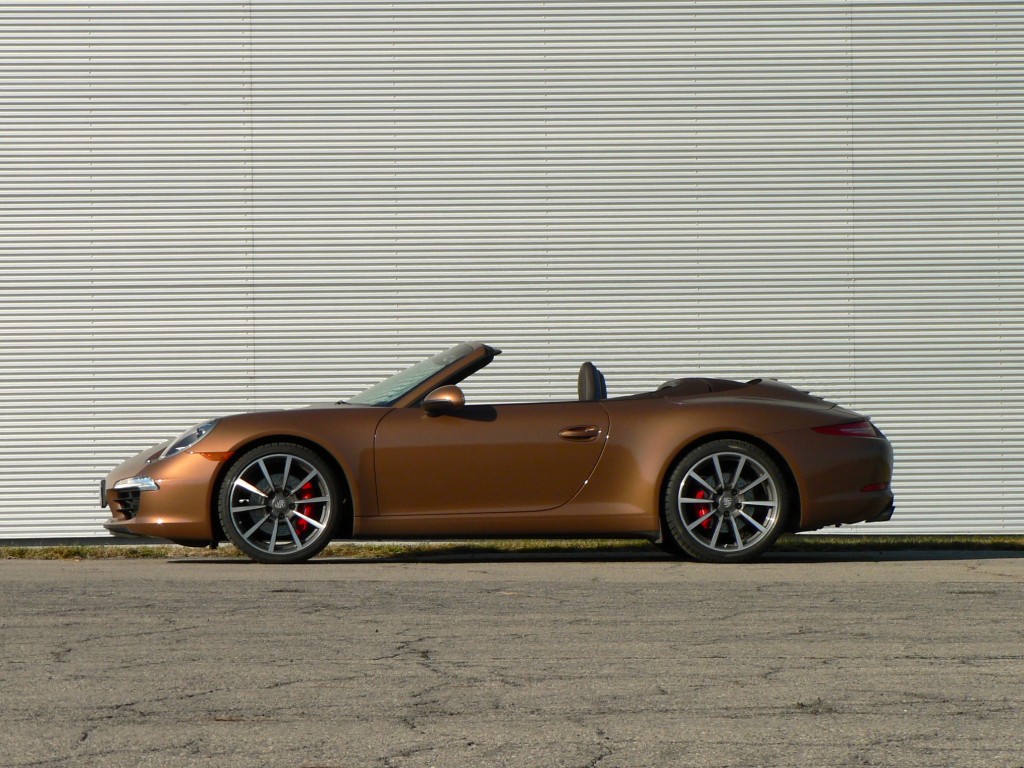 As a rear-engine, rear-wheel-drive, 2+2 convertible, the 911 Carrera S Cabriolet has no technical peers. But buyers in this segment may also be looking at a $139,600 (all “starting” prices) Aston Martin Vantage Roadster, $128,900 BMW M6 Cabriolet or $123,900 Mercedes-Benz SL 550 Roadster.
For only the third time since the original 1964 version, the 911 family resides on an all-new platform. It’s measurably larger overall, with interior occupants benefitting from an airier cabin. The new 911 Carrera hardtops and convertibles have also adopted the wide, centre-console design first seen on the Panamera sedan and Cayenne SUV. Even in Cabriolet form, the new 911 Carrera S is quieter than the outgoing version, with a lot less tire noise. While front passengers have few qualms with the newfound space in the 911, the Cabriolet’s pair of rear jump seats still won’t carry adult-sized humans comfortably for any length of time. But fold them down, and you get a bit more luggage space to complement the Porsche’s 1,351 litres of front trunk space.
Obviously, the biggest difference the convertible has over its hardtop 911 brethren is its ability to open and close its roof. Stylistically, when erect, Porsche designers have tried to mimic the tiptop’s roof profile. Porsche says its takes only 13 seconds to lower the cloth-covered roof and have the hard, rear tonneau cover shut in place. You can operate the roof at speeds up to 50 km/h, and its available in four colours. (My tester’s roof was Brown, a nice complement to its Cognac exterior paint.) There’s also a power-actuated wind deflector that can only be used when the rear seats are empty of passengers.
As a rear-engine, rear-wheel-drive, 2+2 convertible, the 911 Carrera S Cabriolet has no technical peers. But buyers in this segment may also be looking at a $139,600 (all “starting” prices) Aston Martin Vantage Roadster, $128,900 BMW M6 Cabriolet or $123,900 Mercedes-Benz SL 550 Roadster.
For only the third time since the original 1964 version, the 911 family resides on an all-new platform. It’s measurably larger overall, with interior occupants benefitting from an airier cabin. The new 911 Carrera hardtops and convertibles have also adopted the wide, centre-console design first seen on the Panamera sedan and Cayenne SUV. Even in Cabriolet form, the new 911 Carrera S is quieter than the outgoing version, with a lot less tire noise. While front passengers have few qualms with the newfound space in the 911, the Cabriolet’s pair of rear jump seats still won’t carry adult-sized humans comfortably for any length of time. But fold them down, and you get a bit more luggage space to complement the Porsche’s 1,351 litres of front trunk space.
Obviously, the biggest difference the convertible has over its hardtop 911 brethren is its ability to open and close its roof. Stylistically, when erect, Porsche designers have tried to mimic the tiptop’s roof profile. Porsche says its takes only 13 seconds to lower the cloth-covered roof and have the hard, rear tonneau cover shut in place. You can operate the roof at speeds up to 50 km/h, and its available in four colours. (My tester’s roof was Brown, a nice complement to its Cognac exterior paint.) There’s also a power-actuated wind deflector that can only be used when the rear seats are empty of passengers.
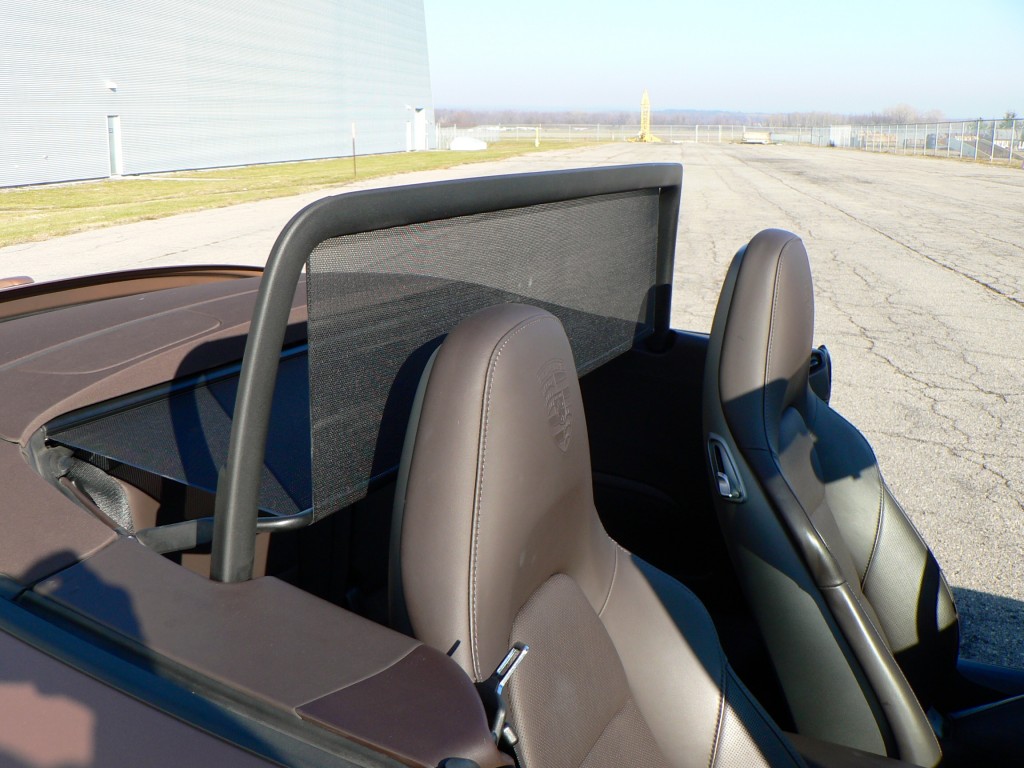 If you can afford a car like the 911 Carrera S Cabriolet, it’s safe to assume you also have other valuable items. So Porsche’s gone out of its way to make the new 911 convertible’s cloth roof as impregnable to thieves as rival full-metal versions (i.e. the Mercedes-Benz SL). Sandwiched in the roof’s folding apparatus are cast magnesium panels. Mated to the top’s magnesium-framed rear glass, potential thieves have little space to get into the Porsche, even if they sliced away the roof’s cloth surface. Despite all this extra hardware, Porsche says the roof weighs the same as the outgoing 911 Carrera Cabriolet.
Despite the new 911 Carrera S Cabriolet’s dimensions growing in every area, it’s still one of the best performing cars in its class. With 400 horsepower and 325 pound-feet of torque, the S version of the Carrera’s 3.8-litre flat six-cylinder engine can’t match the ratings from convertible rivals like the Aston Martin V8 Vantage (420 h.p; 346 lb-ft), ‘Benz SL 550 (429 hp; 516 lb-ft) or BMW M6 (560 hp; 500 lb-ft). But the Porsche’s 4.5 seconds 0-100 km/h time (when using the optional seven-speed dual-clutch autobox’s launch control feature) betters all the above expect for the 0.2 seconds quicker BMW.
The Porsche’s comparably lighter weight also helps out at the pumps. Not that anyone will ever match its Transport Canada estimates (I saw a 9.8 L/100 km average in my week with the car), the 911 Carrera S Cabriolet’s’ 10.9 city and 7.3 highway ratings easily best all the above-mentioned rivals.
If you can afford a car like the 911 Carrera S Cabriolet, it’s safe to assume you also have other valuable items. So Porsche’s gone out of its way to make the new 911 convertible’s cloth roof as impregnable to thieves as rival full-metal versions (i.e. the Mercedes-Benz SL). Sandwiched in the roof’s folding apparatus are cast magnesium panels. Mated to the top’s magnesium-framed rear glass, potential thieves have little space to get into the Porsche, even if they sliced away the roof’s cloth surface. Despite all this extra hardware, Porsche says the roof weighs the same as the outgoing 911 Carrera Cabriolet.
Despite the new 911 Carrera S Cabriolet’s dimensions growing in every area, it’s still one of the best performing cars in its class. With 400 horsepower and 325 pound-feet of torque, the S version of the Carrera’s 3.8-litre flat six-cylinder engine can’t match the ratings from convertible rivals like the Aston Martin V8 Vantage (420 h.p; 346 lb-ft), ‘Benz SL 550 (429 hp; 516 lb-ft) or BMW M6 (560 hp; 500 lb-ft). But the Porsche’s 4.5 seconds 0-100 km/h time (when using the optional seven-speed dual-clutch autobox’s launch control feature) betters all the above expect for the 0.2 seconds quicker BMW.
The Porsche’s comparably lighter weight also helps out at the pumps. Not that anyone will ever match its Transport Canada estimates (I saw a 9.8 L/100 km average in my week with the car), the 911 Carrera S Cabriolet’s’ 10.9 city and 7.3 highway ratings easily best all the above-mentioned rivals.
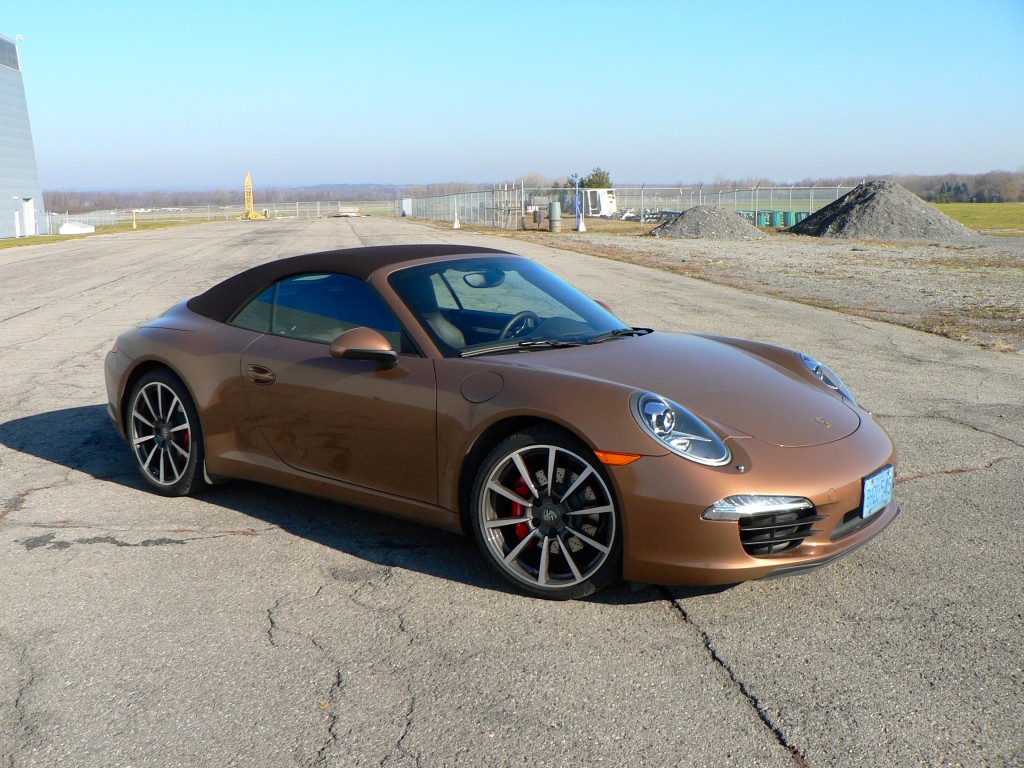 While the new 911 Carrera S Cabriolet’s larger dimensions subjectively make it more intimidating on tight, twisty roads, Porsche has done a remarkable job getting the new 2+2 to weigh about the same as the outgoing model. Even with an open-roof structure that had to be stiffened, its 1,485 kilograms curb weight is similar to the outgoing model. As in the new Boxster (which shares many of its front-end parts with big brother 911), the new 911 Carrera has adopted electric steering instead of the traditional hydraulic setup. Traditionalists have been moaning that these new e-steering setups lack feel and the tactile communication older systems had in droves. Not so in my 911 Carrera S Cabriolet. Laser-quality accuracy was delivered. And turning the Porsche’s steering wheel brings instant and rich feedback. Plus the front wheels don’t seem to hop over rough pavement as in older 911s.
What hasn’t changed much is the 911 Carrera S Cabriolet’s ride quality: still one of the firmest in its class — certainly tauter than its Mercedes or BMW competition. However, the Porsche Active Suspension Management (standard on all 911 Carrera S models), that swaps out anti-roll bar links for hydraulic actuators, can tune the ride quality an infinite number of ways. The result on the road is a car that maintains a horizontal state in even the sharpest turns, allowing its low-profile rubber to do its job with the maximum amount of grip as possible. And the best way to do that is setting the PASM to Sport-plus mode, which sharpens the shifts in the transmission and widens the car’s stability control system’s limits.
While the new 911 Carrera S Cabriolet’s larger dimensions subjectively make it more intimidating on tight, twisty roads, Porsche has done a remarkable job getting the new 2+2 to weigh about the same as the outgoing model. Even with an open-roof structure that had to be stiffened, its 1,485 kilograms curb weight is similar to the outgoing model. As in the new Boxster (which shares many of its front-end parts with big brother 911), the new 911 Carrera has adopted electric steering instead of the traditional hydraulic setup. Traditionalists have been moaning that these new e-steering setups lack feel and the tactile communication older systems had in droves. Not so in my 911 Carrera S Cabriolet. Laser-quality accuracy was delivered. And turning the Porsche’s steering wheel brings instant and rich feedback. Plus the front wheels don’t seem to hop over rough pavement as in older 911s.
What hasn’t changed much is the 911 Carrera S Cabriolet’s ride quality: still one of the firmest in its class — certainly tauter than its Mercedes or BMW competition. However, the Porsche Active Suspension Management (standard on all 911 Carrera S models), that swaps out anti-roll bar links for hydraulic actuators, can tune the ride quality an infinite number of ways. The result on the road is a car that maintains a horizontal state in even the sharpest turns, allowing its low-profile rubber to do its job with the maximum amount of grip as possible. And the best way to do that is setting the PASM to Sport-plus mode, which sharpens the shifts in the transmission and widens the car’s stability control system’s limits.
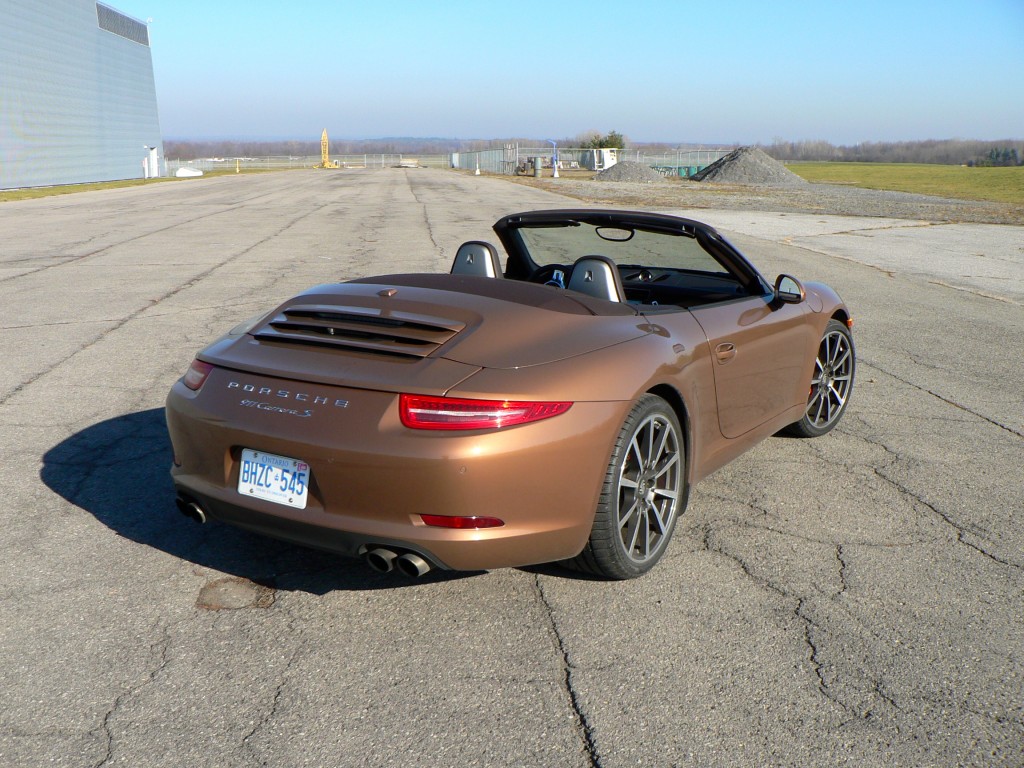 Fewer and fewer 911 buyers are ordering manual gearboxes anymore. So it was appropriate that my media fleet model came equipped with Porsche’s dual-clutch auto box, marketed as PDK; short form for the lengthy doppelkupplungsgetriebe German translation. When choosing its sportiest settings, the PDK’s seven speeds can be down- or up-shifted quicker than any human can work a manual box’s clutch and gear change. Subjectively, though, like the plethora of e-nannies that keep the rear-engine 911 Carrera from pirouetting into the bushes from ham-fisted drivers, sports car fetishists will prefer the stick.
Like the new hardtop, the 2013 911 Carrera S Cabriolet ushers in a new era for Porsche’s iconic car. No doubt, it’s easily the most comfortable and capable 911 convertible ever. Between its roomier cabin, PDK autobox, electronic driving aids and luxury-car comforts, buyers looking for a modern, high-performance 2+2 will find few faults. And if you feel the need for traction at all four wheels, all-wheel-drive Carrera 4 models are available now as well.
That said, old school 911 fans may be disappointed. Although Porsche still markets the 911 Carrera as a “sports car”, my personal auto code of ethics calls it a “grand tourer” — or “GT” — car. If you want a “real” Porsche sports car, the smaller, mid-engine Boxster roadster and its arriving-this-spring Cayman coupe will fill that bill.
Road Test: 2013 Porsche 911 Carrera S Cabriolet
WHAT I LIKED: Convertible top offers hardtop comfort and security; easiest 911 to drive ever; more room yet less weight
WHAT I DIDN'T: Bigger body moves 911 into GT class; electronics leaves less challenges for drivers; near-exotic car pricing
Base price/as-tested: $ $123,200$162,060
Type of vehicle: RWD, 2+2 convertible
Engines: 3.8L F6
Power: 400 hp
Torque: 324 lb-ft.
Transmission: Seven-speed dual-clutch automatic
Fuel consumption L/100 km: 10.9 city; 7.3 hwy; 9.8 as-tested
Competition: Aston Martin V8 Vantage, BMW M6, Mercedes-Benz SL 550
Fewer and fewer 911 buyers are ordering manual gearboxes anymore. So it was appropriate that my media fleet model came equipped with Porsche’s dual-clutch auto box, marketed as PDK; short form for the lengthy doppelkupplungsgetriebe German translation. When choosing its sportiest settings, the PDK’s seven speeds can be down- or up-shifted quicker than any human can work a manual box’s clutch and gear change. Subjectively, though, like the plethora of e-nannies that keep the rear-engine 911 Carrera from pirouetting into the bushes from ham-fisted drivers, sports car fetishists will prefer the stick.
Like the new hardtop, the 2013 911 Carrera S Cabriolet ushers in a new era for Porsche’s iconic car. No doubt, it’s easily the most comfortable and capable 911 convertible ever. Between its roomier cabin, PDK autobox, electronic driving aids and luxury-car comforts, buyers looking for a modern, high-performance 2+2 will find few faults. And if you feel the need for traction at all four wheels, all-wheel-drive Carrera 4 models are available now as well.
That said, old school 911 fans may be disappointed. Although Porsche still markets the 911 Carrera as a “sports car”, my personal auto code of ethics calls it a “grand tourer” — or “GT” — car. If you want a “real” Porsche sports car, the smaller, mid-engine Boxster roadster and its arriving-this-spring Cayman coupe will fill that bill.
Road Test: 2013 Porsche 911 Carrera S Cabriolet
WHAT I LIKED: Convertible top offers hardtop comfort and security; easiest 911 to drive ever; more room yet less weight
WHAT I DIDN'T: Bigger body moves 911 into GT class; electronics leaves less challenges for drivers; near-exotic car pricing
Base price/as-tested: $ $123,200$162,060
Type of vehicle: RWD, 2+2 convertible
Engines: 3.8L F6
Power: 400 hp
Torque: 324 lb-ft.
Transmission: Seven-speed dual-clutch automatic
Fuel consumption L/100 km: 10.9 city; 7.3 hwy; 9.8 as-tested
Competition: Aston Martin V8 Vantage, BMW M6, Mercedes-Benz SL 550
06.06.13 | 2013, Car Buying Advice, Porsche, road tests | Comments Off on Road Test: 2013 Porsche 911 Carrera S Cabriolet




